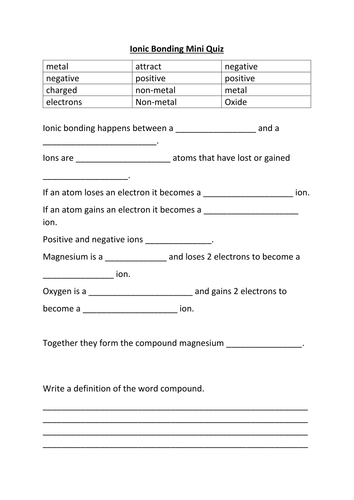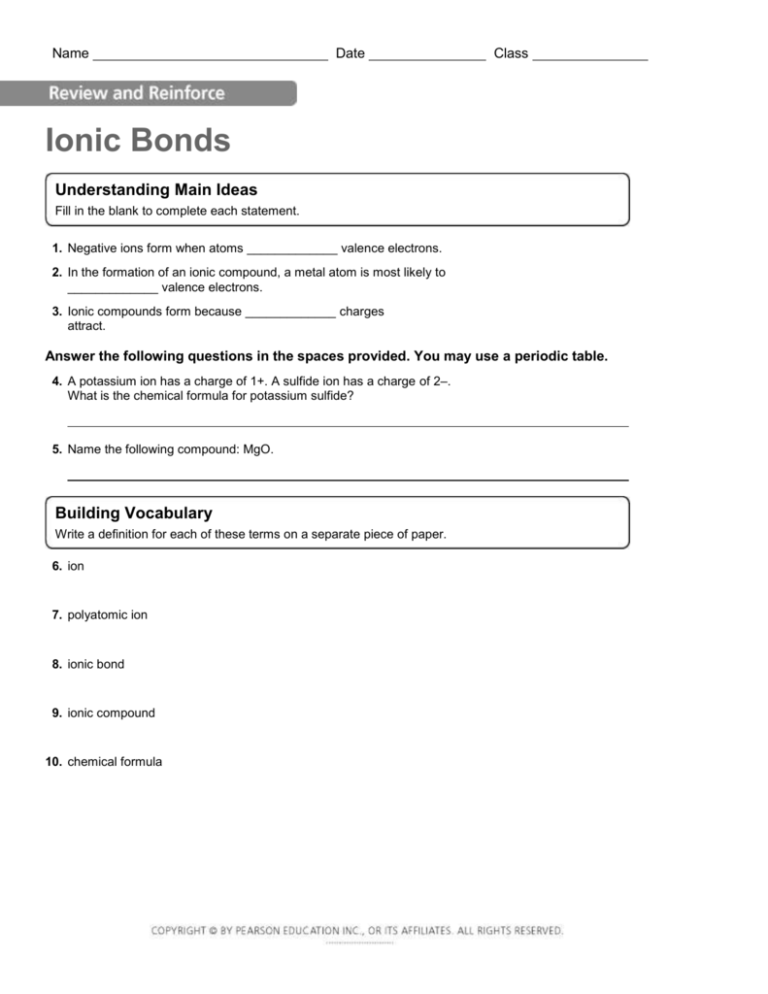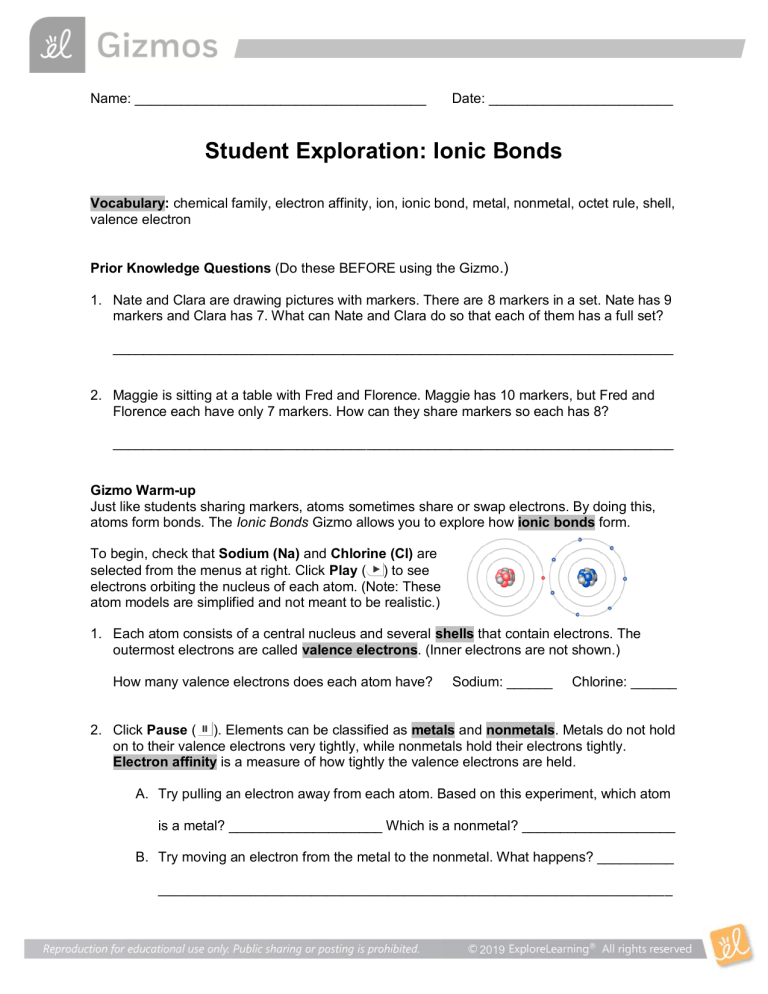Electrons Are Blank in an Ionic Bond
Each atom strives to achieve a full outer shell of electrons. For instance NaCl is formed by a transfer of one electron from sodium to chlorine.
But in ionic bonding electrons are transferred from one atom to the other and not shared like in covalent bonding.

. Anatomy and Physiology questions and answers. Electrovalent bonds are only formed between metals and non-metals. Ions are atoms with an electrostatic charge.
Ionic bonding is simply the electrostatic forces of attraction between ions and ions have charge because they have more electronsless electrons than they do protons. Ionic bonding is a type of chemical bond in which valence electrons are lost from one atom and gained by another. We saw this in the formation of NaCl.
Therefore ionic bonding is the bonding between metals and non-metals. They are typically soluble in water some have very low solubility. In an ionic bond the atoms are bound by attraction of opposite ions whereas in a covalent bond atoms are bound by sharing electrons.
Students will use Styrofoam balls to make models of the ionic bonding in sodium chloride salt. In covalent bonding the geometry around each atom is determined by valence shell electron pair repulsion theory VSEPR rules whereas in ionic materials the geometry follows maximum packing rules. Fill in the blanks.
Electrons are in an ionic bond whereas they are in a polar covalent bond and in a nonpolar covalent bond Chemistry UNIT 2. This exchange results in a more stable noble gas electronic configuration for both atoms involved. Ionic bonds are a class of chemical bonds that result from the exchange of one or more valence electrons from one atom typically a metal to another typically a nonmetal.
In the formation of an ionic compound metals lose electrons and nonmetals gain electrons to achieve an octet. Ionic bonding is a type of chemical bonding that involves the electrostatic attraction between oppositely charged ions or between two atoms with sharply different electronegativities and is the primary interaction occurring in ionic compounds. Electron Transfer Between Na and Cl.
Metals such as sodium losses electrons to to become positive ion whereas non-metal such as chlorine accepts electrons to become a negative ion. The metallic elements on the left side of the periodic table have electrons in excess of the stable configuration. Ionic solids are also poor conductors of electricity for the same reasonthe strength of ionic bonds prevents ions from moving freely in the solid state.
The attraction between oppositely charged ions is called an ionic bond and it is one of the main types of chemical bonds in chemistry. They also tend to have high melting and boiling points which suggests that ionic bonds are very strong. For each blank write a word that is an antonym of the italicized.
Click hereto get an answer to your question Fill in the blanksAn ionic bond is formed by. Students will be able to explain the process of the formation of ions and ionic bonds. If electrons are transfered completely it is due to very high difference in electronegativity of the com.
In this example sodium loses one electron to empty its shell and chlorine accepts that electron to fill its shell. Metals have an excess and non-metals have a dearth of. Electrons are in an ionic bond whereas they are in a polar covalent bond and in a nonpolar covalent bond Chemistry UNIT 25.
It is one of the main types of bonding along with covalent bonding and metallic bonding. In electron transfer the number of electrons lost must equal the number of electrons gained. This electron exchange results in an electrostatic attraction between the two atoms called an ionic bond.
Electrons are transferred in an ionic bond whereas they are unequally shared in a polar covalent bond are equally blank in a nonpolar covalent bond. Ionic bonds are formed between ions with opposite charges. A chemical bond is formed by either sharing or transfer of electrons.
They do NOT conduct electricity in the BLANK form but conducts electricity in the molten state and the aqueous state. He has been accused of theft but we feel sure that after the trial he will be Absolved. An atom that loses one or more valence electrons to become a positively charged ion is.
Properties of Ionic Compounds. A polar covalent bond is formed by an. The attraction of an atom for a shared pair of electrons.
View the full answer. Although atoms with equal numbers of protons and electrons exhibit no electrical charge it is common for atoms to attain the stable electronic configuration of the inert gases by either gaining or losing electrons. A blank forms between a metal and a non metal or polyatomic ion.
The bond which is formed by the transfer of electrons between the atoms is called electrovalent bond or ionic bond. Electrovalent bonds are produced when electrons are transferred from atoms of one element to atoms of another element producing positive and negative ions. An ionic bond is based on attractive electrostatic forces between two ions of opposite charge.
Ionic bond is a kind of chemical bond which involves an electrostatic attraction between two oppositely charged ions because of the complete transfer of valence electrons between them. Ionic bonds are caused by electrons transferring from one atom to another. Question-specific help is provided for the struggling learner.
A blank forms between 2 or more non metals. 7 Fill in the blanks. An ionic bond involved the transfer of electrons from one atom to another.
The Ionic Bonding Concept Builder challengers learners to grasp when and how an ionic bond is formed. Such help consists of short. Ionic solids exhibit a crystalline structure and tend to be rigid and brittle.
This type of ionic compound is formed when one kind of metal reacts with one kind of nonmetal. Ionic bonds are formed when atoms _____ electrons while covalent bonds are formed when atoms _____ electrons. An ionic bond between atoms forms when the electrons in the outer layers of two different atoms will add up to 8 so they can combine to make a compound with a full outer layer of electrons.
The two different atoms are able to combine their electrons to become stable. There are three interactive exercises that incrementally lead to an understanding of an ionic bond forming between metal and nonmetal elements through the transfer of electrons.

Plenary Fill The Gap Worksheet For Ionic Bonding Teaching Resources


.PNG)
Comments
Post a Comment